General Sir John Monash, Personal Files Book 17, 1 November 1917 - 13 January 1918, Part 1
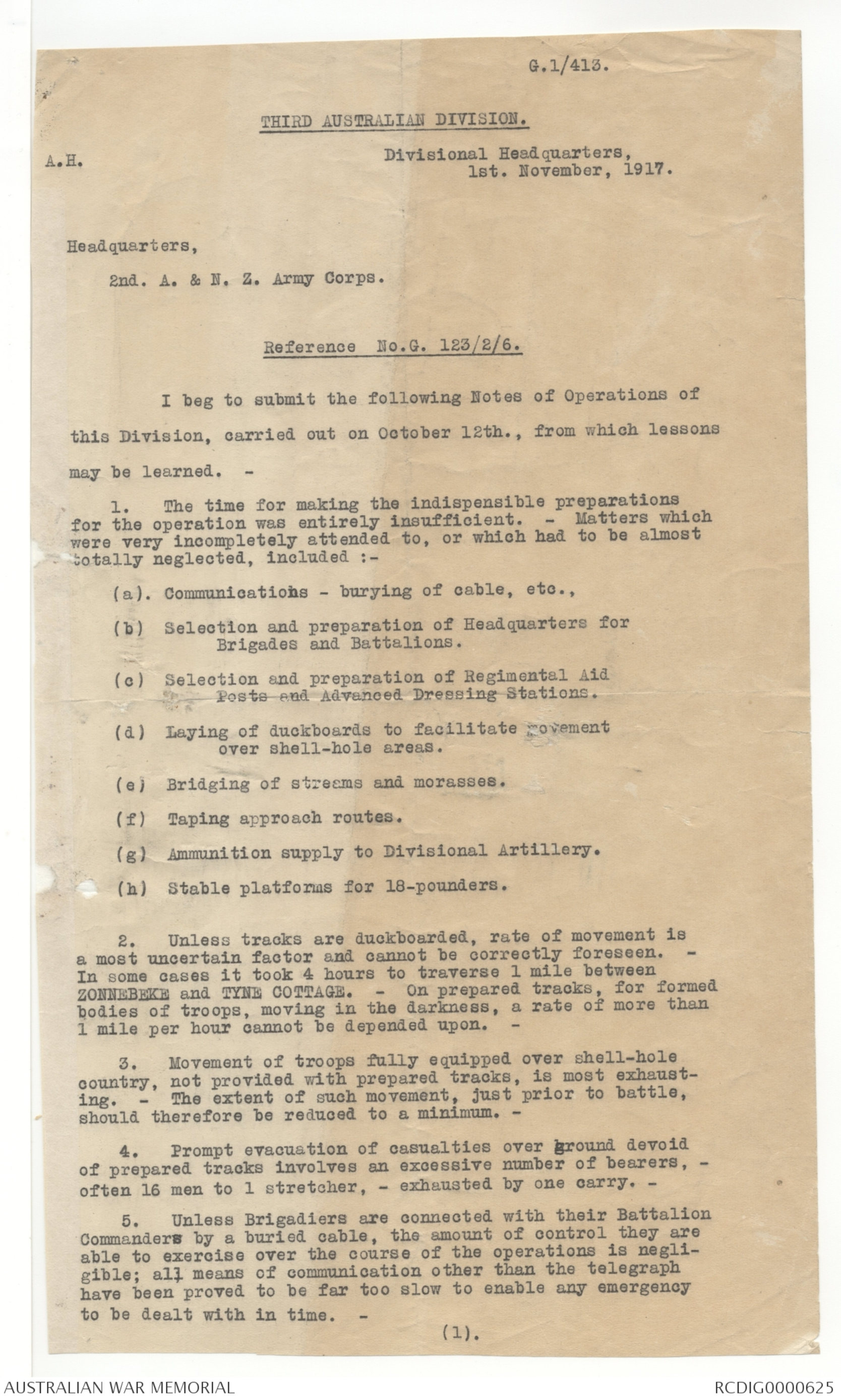
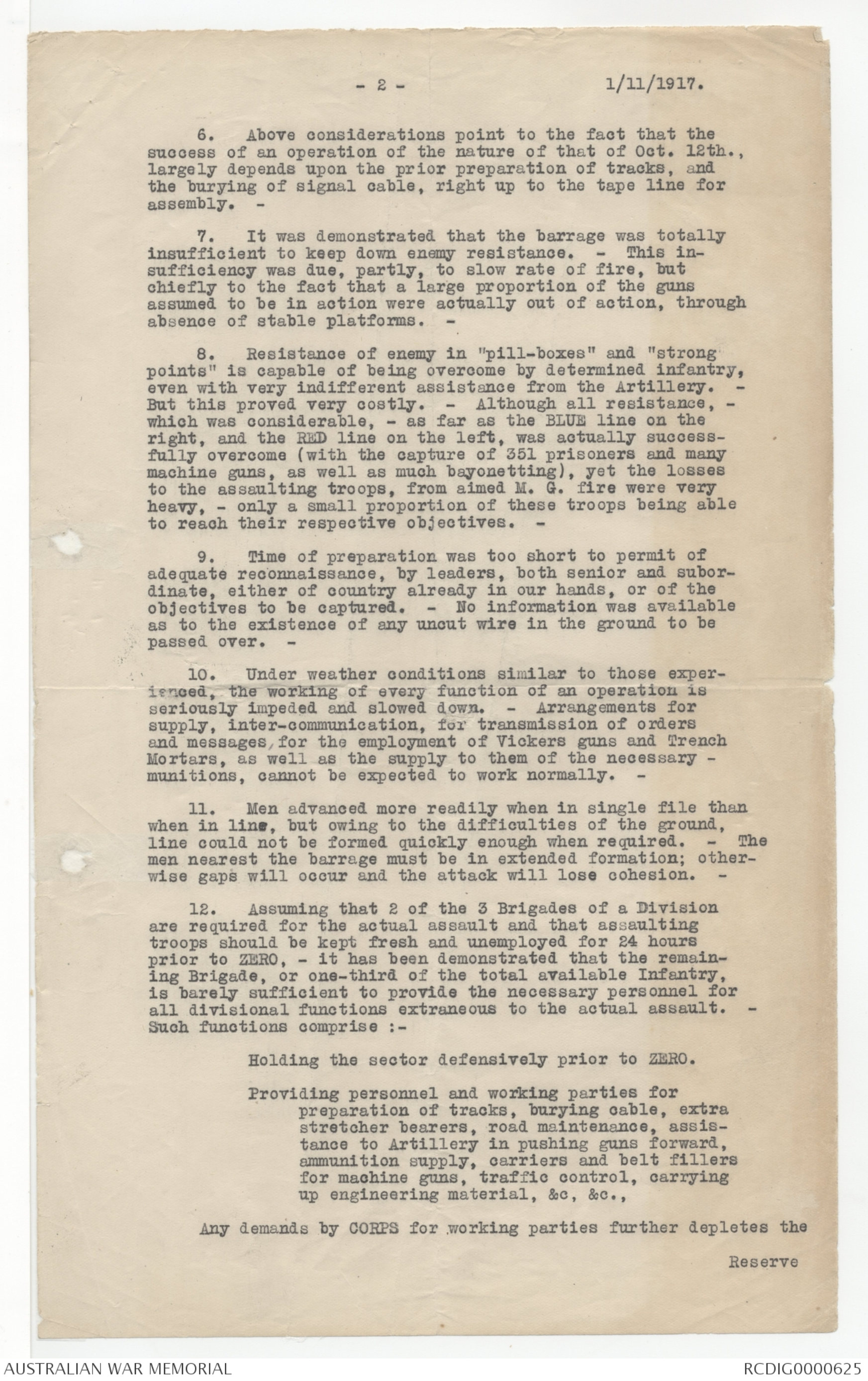
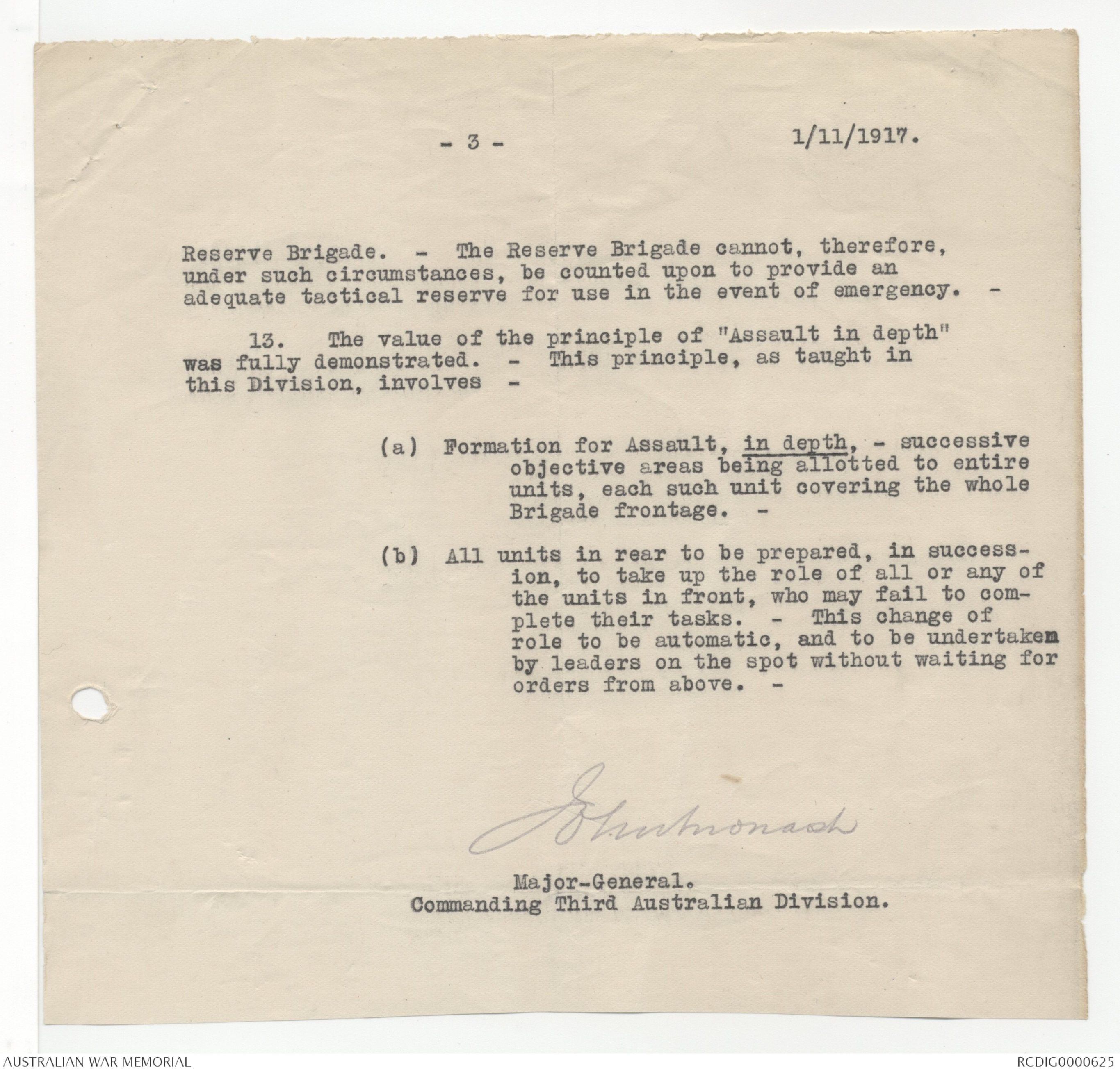
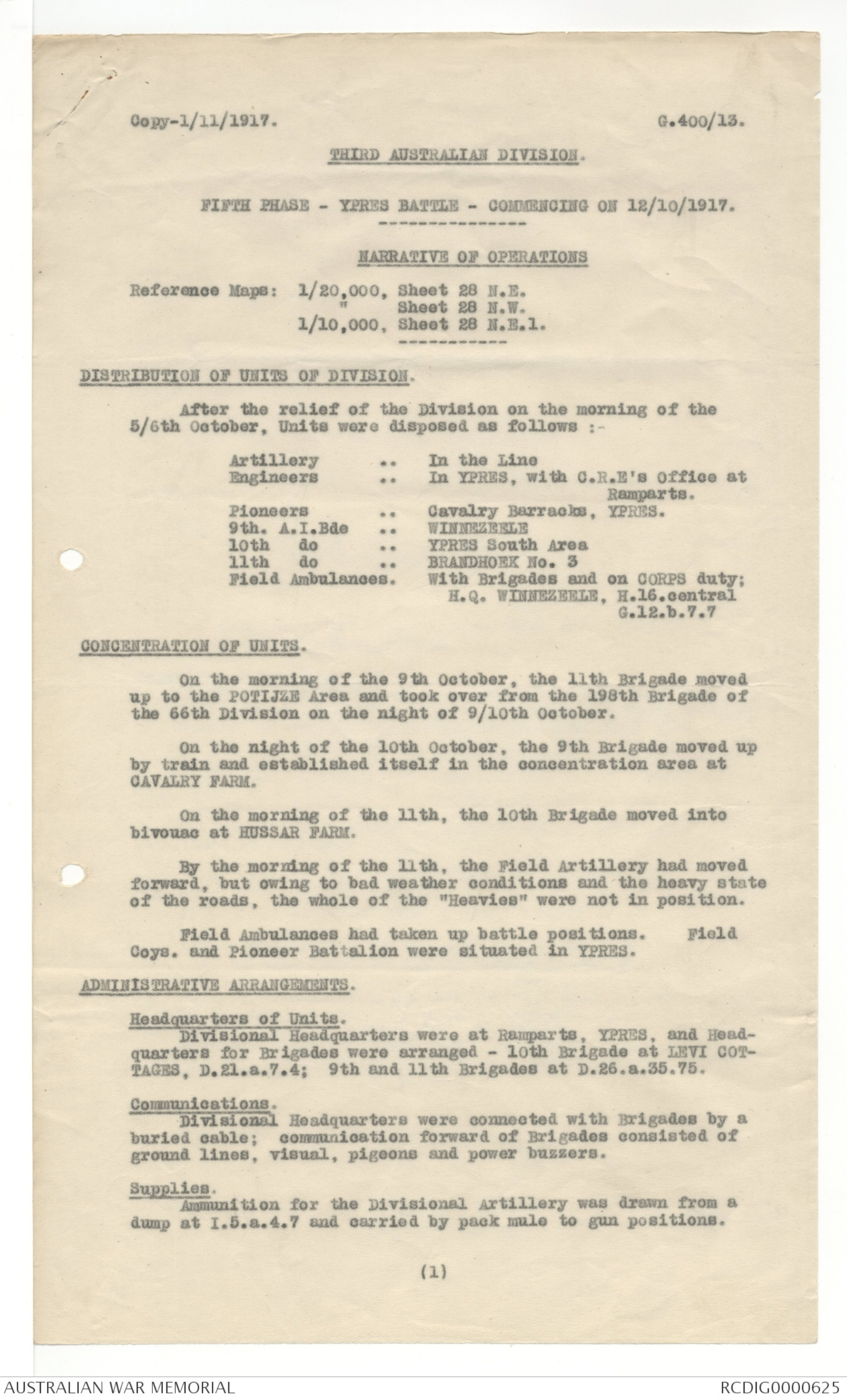
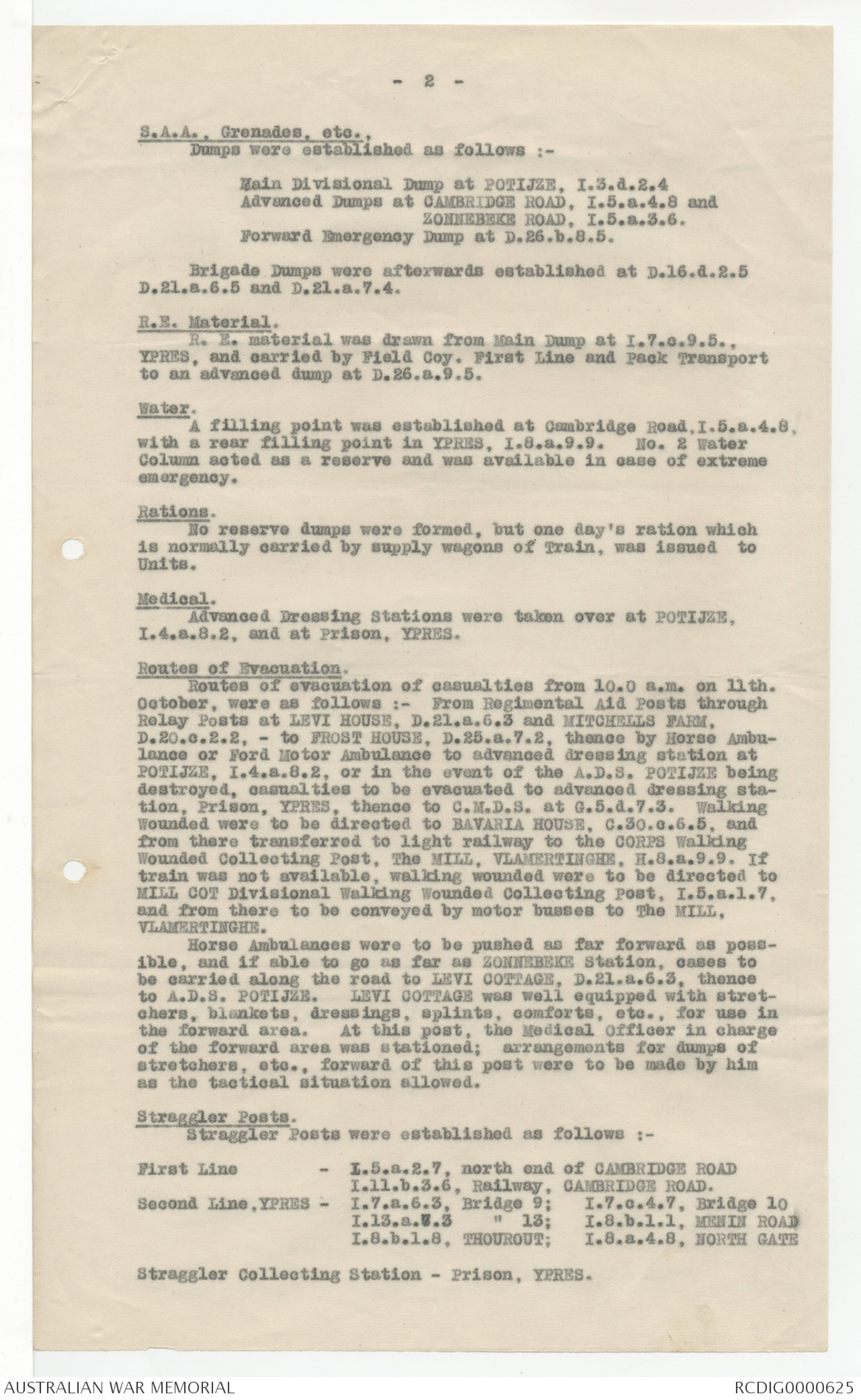
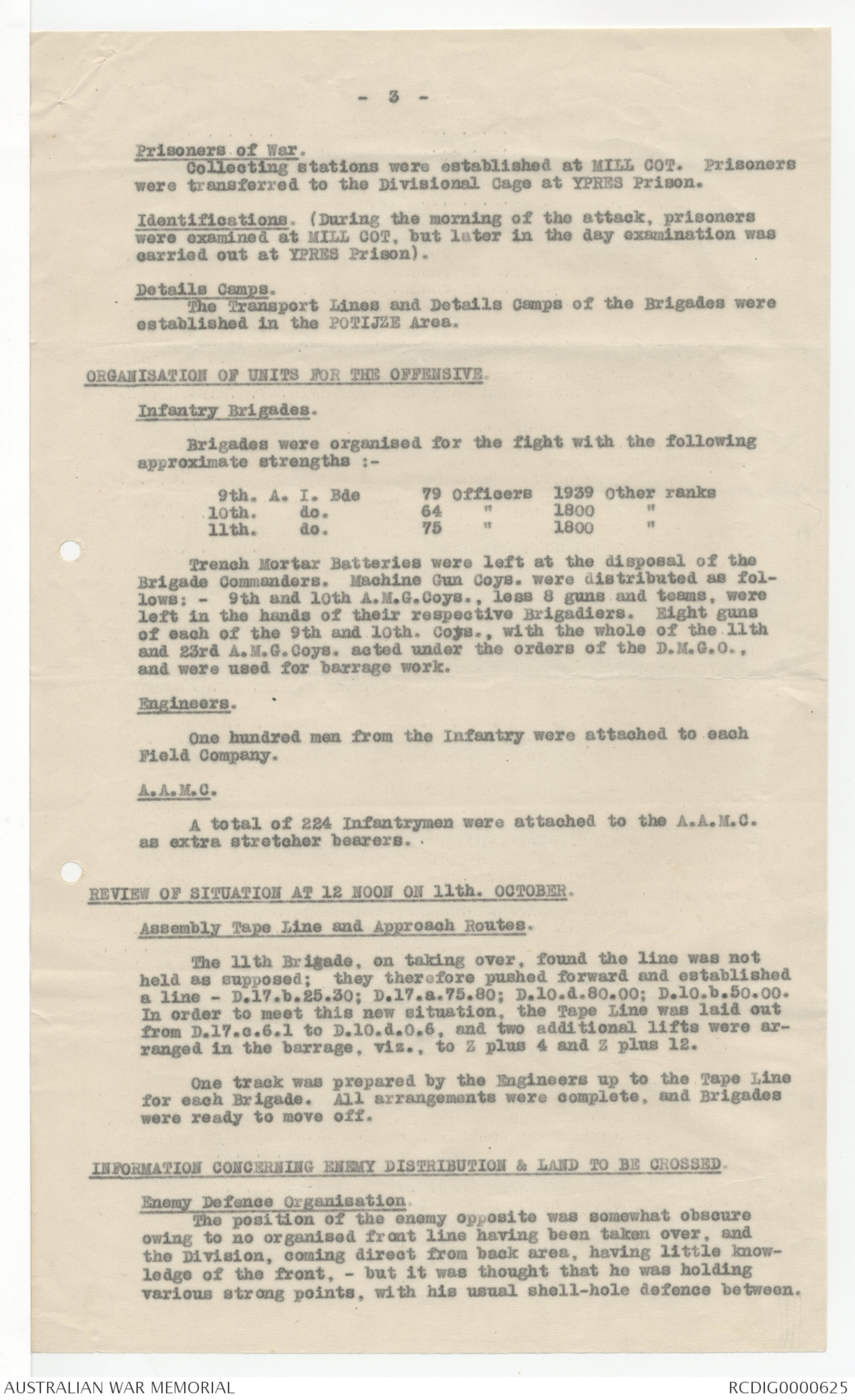
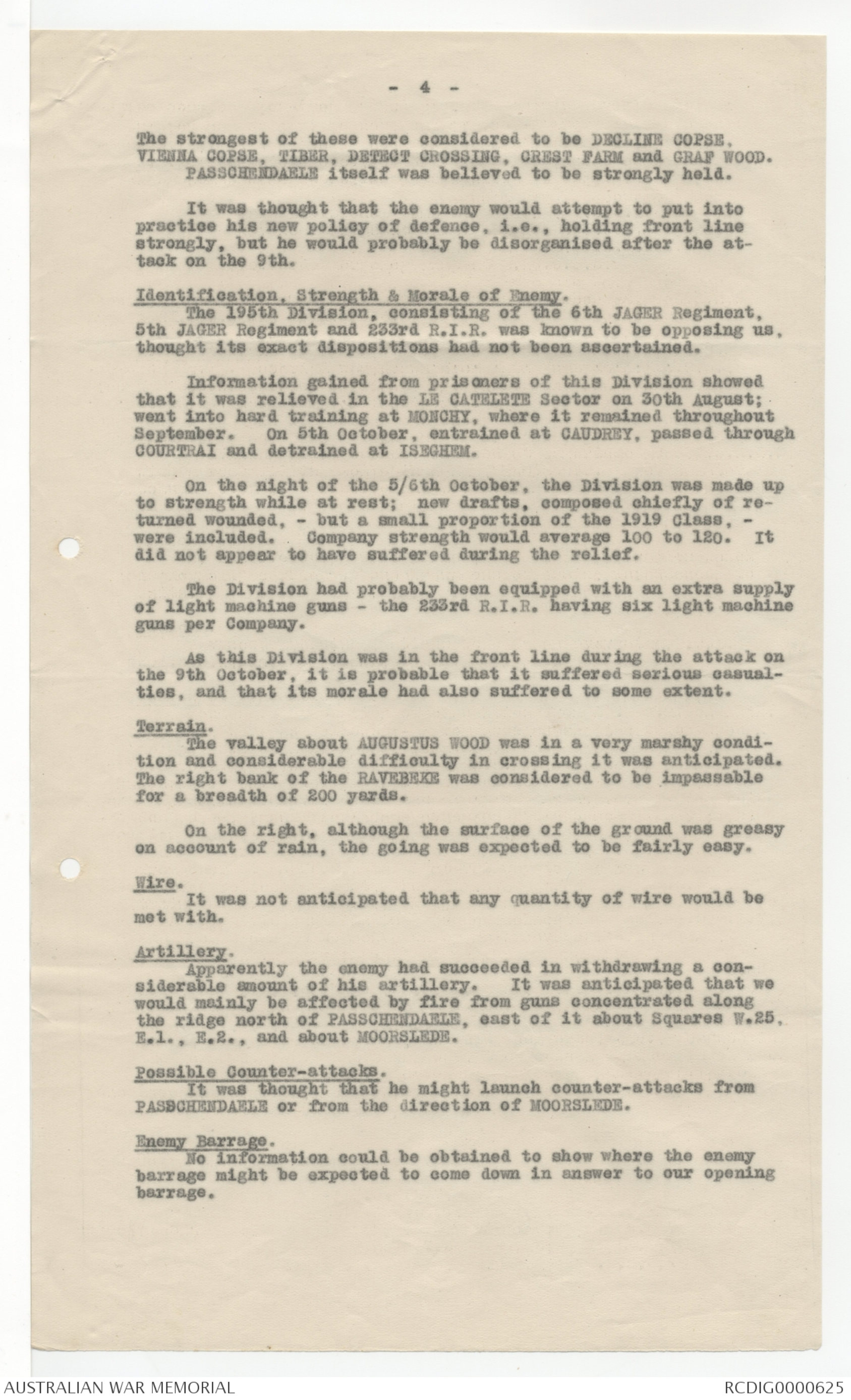
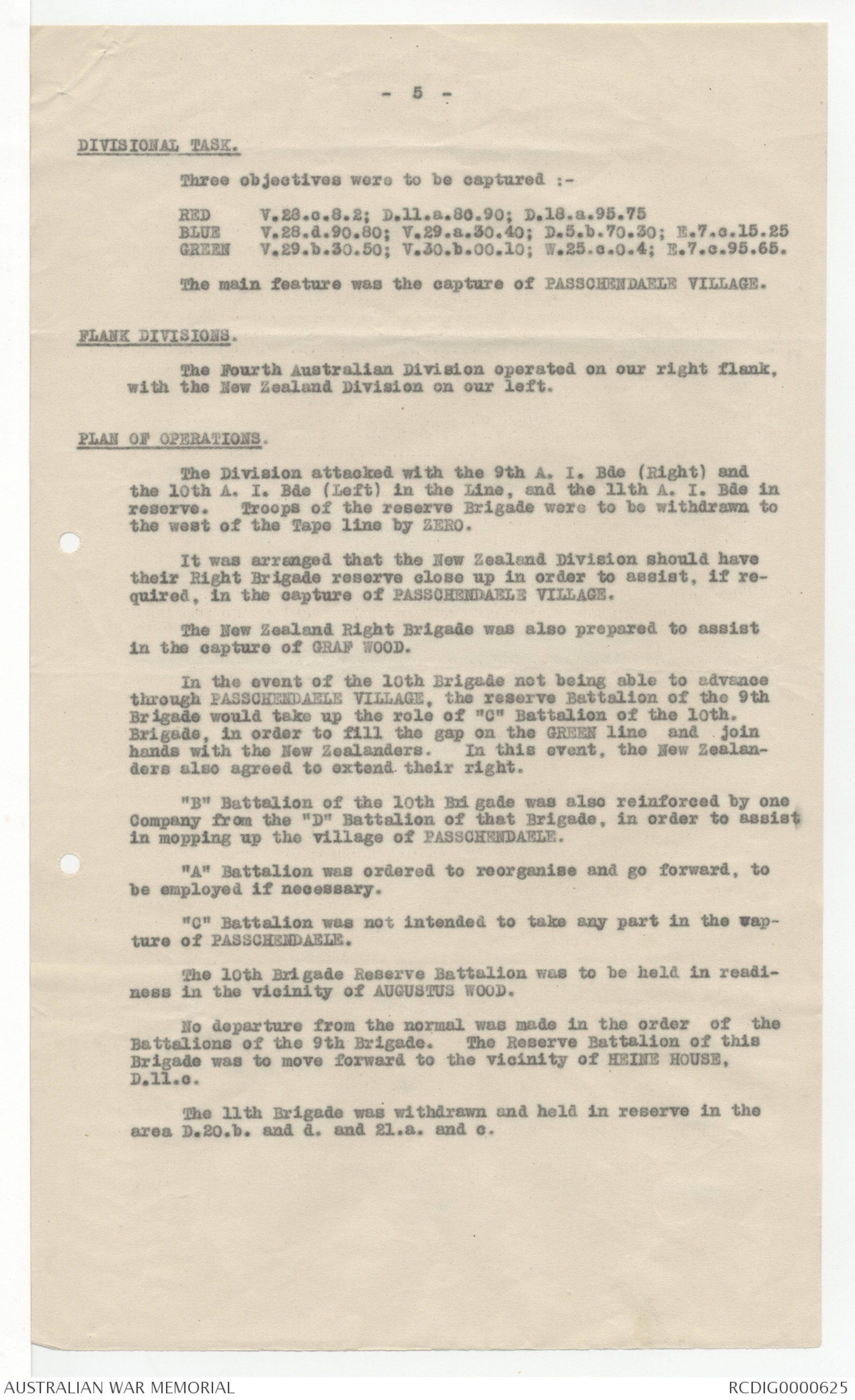
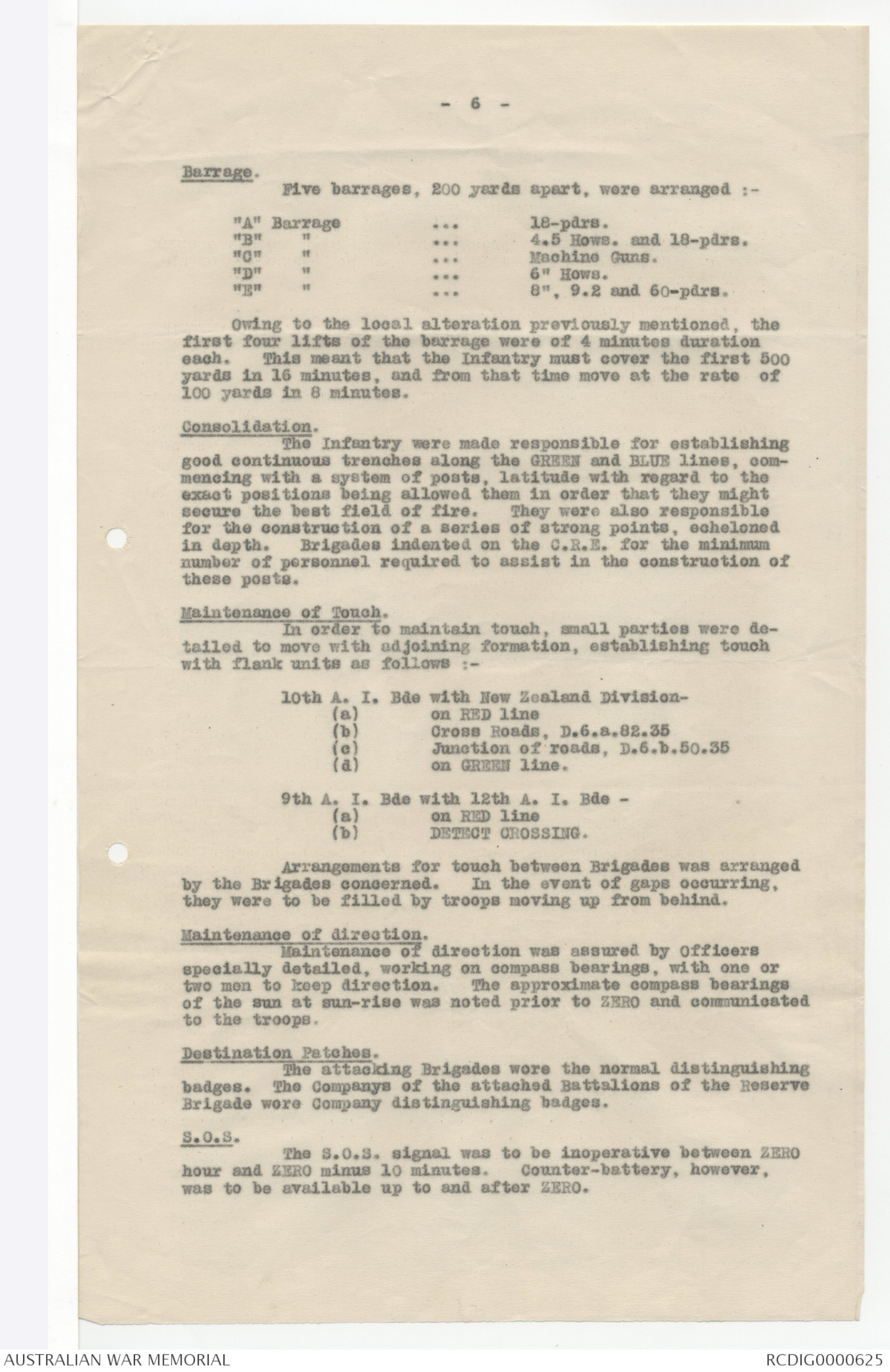
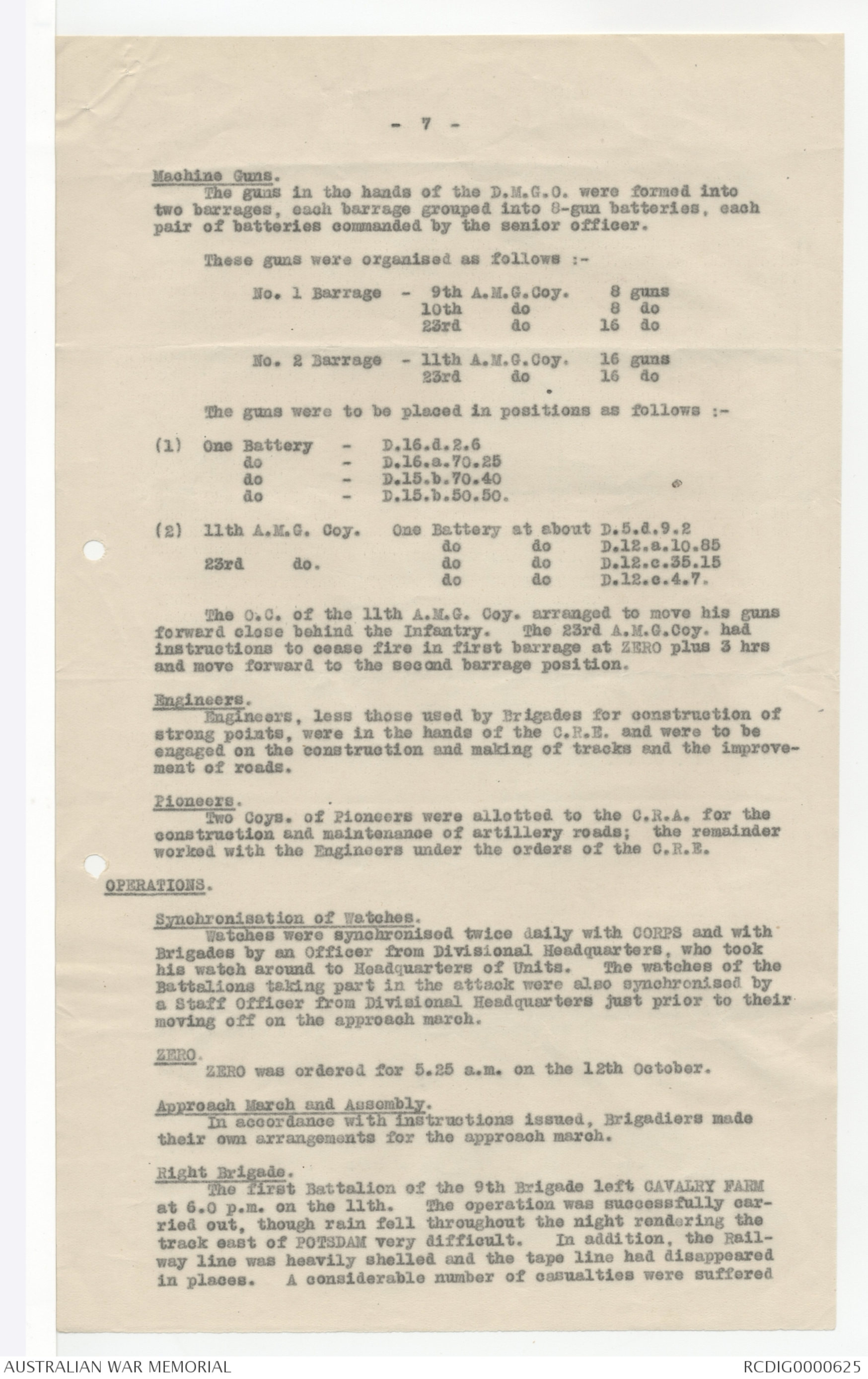
G.1/413.
THIRD AUSTRALIAN DIVISION.
A.H.
Divisional Headquarters,
1st. November, 1917.
Headquarters,
2nd. A. & N. Z. Army Corps.
Reference No.G. 123/2/6.
I beg to submit the following Notes of Operations of
this Division, carried out on October 12th., from which lessons
may be learned. -
1. The time for making the indispensible preparations
for the operation was entirely insufficient. - Matters which
were very incompletely attended to, or which had to be almost
totally neglected, included:-
(a). Communications - burying of cable, etc.,
(b) Selection and preparation of Headquarters for
Brigades and Battalions.
(c) Selection and preparation of Regimental Aid
Posts and Advanced Dressing Stations.
(d) Laying of duckboards to facilitate movement
over shell-hole areas.
(e) Bridging of streams and morasses.
(f) Taping approach routes.
(g) Ammunition supply to Divisional Artillery.
(h) Stable platforms for 18-pounders.
2. Unless tracks are duckboarded, rate of movement is
a most uncertain factor and cannot be correctly foreseen. -
In some cases it took 4 hours to traverse 1 mile between
ZONNEBEKE and TYNE COTTAGE. - On prepared tracks, for formed
bodies of troops, moving in the darkness, a rate of more than
1 mile per hour cannot be depended upon. -
3. Movement of troops fully equipped over shell-hole
country, not provided with prepared tracks, is most exhausting.
- The extent of such movement, just prior to battle,
should therefore be reduced to a minimum. -
4. Prompt evacuation of casualties over ground devoid
of prepared tracks involves an excessive number of bearers, -
often 16 men to 1 stretcher, - exhausted by one carry. -
5. Unless Brigadiers are connected with their Battalion
Commanders by a buried cable, the amount of control they are
able to exercise over the course of the operations is negligible;
all means of communication other than the telegraph
have been proved to be far too slow to enable any emergency
to be dealt with in time. -
(1).
- 2 -
1/11/1917.
6. Above considerations point to the fact that the
success of an operation of the nature of that of Oct. 12th.,
largely depends upon the prior preparation of tracks, and
the burying of signal cable, right up to the tape line for
assembly. -
7. It was demonstrated that the barrage was totally
insufficient to keep down enemy resistance. - This insufficiency
was due, partly, to slow rate of fire, but
chiefly to the fact that a large proportion of the guns
assumed to be in action were actually out of action, through
absence of stable platforms. -
8. Resistance of enemy in "pill-boxes" and "strong
points" is capable of being overcome by determined infantry,
even with very indifferent assistance from the Artillery. -
But this proved very costly. - Although all resistance,
which was considerable, - as far as the BLUE line on the
right, and the RED line on the left, was actually successfully
overcome (with the capture of 351 prisoners and many
machine guns, as well as much bayonetting), yet the losses
to the assaulting troops, from aimed M. G. fire were very
heavy, - only a small proportion of these troops being able
to reach their respective objectives. -
9. Time of preparation was too short to permit of
adequate reconnaissance, by leaders, both senior and subordinate,
either of country already in our hands, or of the
objectives to be captured. - No information was available
as to the existence of any uncut wire in the ground to be
passed over. -
10. Under weather conditions similar to those experienced,
the working of every function of an operation is
seriously impeded and slowed down. - Arrangements for
supply, inter-communication, for transmission of orders
and messages, for the employment of Vickers guns and Trench
Mortars, as well as the supply to them of the necessary -
munitions, cannot be expected to work normally. -
11. Men advanced more readily when in single file than
when in line, but owing to the difficulties of the ground,
line could not be formed quickly enough when required. - The
men nearest the barrage must be in extended formation; otherwise
gaps will occur and the attack will lose cohesion. -
12. Assuming that 2 of the 3 Brigades of a Division
are required for the actual assault and that assaulting
troops should be kept fresh and unemployed for 24 hours
prior to ZERO, - it has been demonstrated that the remaining
Brigade, or one-third of the total available Infantry,
is barely sufficient to provide the necessary personnel for
all divisional functions extraneous to the actual assault. -
Such functions comprise:
Holding the sector defensively prior to ZERO.
Providing personnel and working parties for
preparation of tracks, burying cable, extra
stretcher bearers, road maintenance, assistance
to Artillery in pushing guns forward,
ammunition supply, carriers and belt fillers
for machine guns, traffic control, carrying
up engineering material, &c, &c.,
Any demands by CORPS for working parties further depletes the
Reserve
- 3 -
1/11/1917.
Reserve Brigade. - The Reserve Brigade cannot, therefore,
under such circumstances, be counted upon to provide an
adequate tactical reserve for use in the event of emergency. -
13. The value of the principle of "Assault in depth"
was fully demonstrated. - This principle, as taught in
this Division, involves -
(a) Formation for Assault, in depth, - successive
objective areas being allotted to entire
units, each such unit covering the whole
Brigade frontage. -
(b) All units in rear to be prepared, in succession,
to take up the role of all or any of
the units in front, who may fail to complete
their tasks. - This change of
role to be automatic, and to be undertaken
by leaders on the spot without waiting for
orders from above. -
John Monash
Major-General.
Commanding Third Australian Division.
Copy-1/11/1917.
G.400/13.
THIRD AUSTRALIAN DIVISION.
FIFTH PHASE - YPRES BATTLE - COMMENCING ON 12/10/1917.
NARRATIVE OF OPERATIONS
Reference Maps: 1/20,000, Sheet 28 N.E.
" Sheet 28 N.W.
1/10,000. Sheet 28 N.E.1.
DISTRIBUTION OF UNITS OF DIVISION.
After the relief of the Division on the morning of the
5/6th October, Units were disposed as follows :-
Artillery . . In the Line
Engineers . . In YPRES, with C.R.E's office at Ramparts.
Pioneers . . Cavalry Barracks, YPRES.
9th. A.I.Bde . . WINNEZEELE
10th do . . YPRES South Area
11th do . . BRANDHOEK No. 3
Field Ambulances. With Brigades and on CORPS duty;
H.Q. WINNEZEELE, H.16.central
G.12.b.7.7
CONCENTRATION OF UNITS.
On the morning of the 9th October, the 11th Brigade moved
up to the POTlJZE Area and took over from the 198th Brigade of
the 66th Division on the night of 9/10th October.
On the night of the 10th October, the 9th Brigade moved up
by train and established itself in the concentration area at
CAVALRY FARM.
On the morning of the 11th, the 10th Brigade moved into
bivouac at HUSSAR FARM.
By the morning of the 11th, the Field Artillery had moved
forward, but owing to bad weather conditions and the heavy state
of the roads, the whole of the "Heavies" were not in position.
Field Ambulances had taken up battle positions. Field
Coys. and Pioneer Battalion were situated in YPRES.
ADMINISTRATIVE ARRANGEMENTS.
Headquarters of Units.
Divisional Headquarters were at Ramparts, YPRES, and Headquarters
for Brigades were arranged - 10th Brigade at LEVI COTTAGES,
D.21.a.7.4; 9th and 11th Brigades at D.26.a.35.75.
Communications.
Divisional Headquarters were connected with Brigades by a
buried cable; communication forward of Brigades consisted of
ground lines, visual, pigeons and power buzzers.
Supplies.
Ammunition for the Divisional Artillery was drawn from a
dump at I.5.a.4.7 and carried by pack mule to gun positions.
(1)
- 2 -
S.A.A. Grenades, etc.,
Dumps were established as follows :-
Main Divisional Dump at POTIJZE, I.3.d.2.4
Advanced Dumps at CAMBRIDGE ROAD, I.5.a.4.8 and
ZONNEBEKE ROAD, I.5.a.3.6.
Forward Emergency Dump at D.26.b.8.5.
Brigade Dumps were afterwards established at D.16.d.2.5
D.21.a.6.5 and D.21.a.7.4.
R.E. Material.
R. E. material was drawn from Main Dump at I.7.c.9.5.,
YPRES, and carried by Field Coy. First Line and Pack Transport
to an advanced dump at D.26.a.9.5.
Water.
A filling point was established at Cambridge Road,I.5.a.4.8.
with a rear filling point in YPRES, I.8.a.9.9. No. 2 Water
Column acted as a reserve and was available in case of extreme
emergency.
Rations.
No reserve dumps were formed, but one day's ration which
is normally carried by supply wagons of Train, was issued to
Units.
Medical.
Advanced Dressing Stations were taken over at POTIJZE,
I.4.a.8.2, and at Prison, YPRES.
Routes of Evacuation.
Routes of evacuation of casualties from 10.0 a.m. on 11th.
October, were as follows :- From Regimental Aid Posts through
Relay Posts at LEVI HOUSE, D. 21.a.6.3 and MITCHELLS FARM.
D.20.c.2.2, - to FROST HOUSE, D.25.a.7.2, thence by Horse Ambulance
or Ford Motor Ambulance to advanced dressing station at
POTIJZE, I.4.a.8.2, or in the event of the A.D.S. POTIJZE being
destroyed, casualties to be evacuated to advanced dressing station,
Prison, YPRES, thence to C.M.D.S. at G.5.d.7.3. Walking
Wounded were to be directed to BAVARIA HOUSE, C.30.c.6.5, and
from there transferred to light railway to the CORPS Walking
Wounded Collecting Post, The MILL, VLAMERTINGHE, H.8.a.9.9. If
train was not available, walking wounded were to be directed to
MILL COT Divisional Walking Wounded Collecting Post, I.5.a.1.7,
and from there to be conveyed by motor busses to The MILL,
VLAMERTINGHE.
Horse Ambulances were to be pushed as far forward as possible,
and if able to go as far as ZONNEBEKE station, cases to
be carried along the road to LEVI COTTACE, D.21.a.6.3, thence
to A.D.S. POTIJZE. LEVI COTTAGE was well equipped with stretchers,
blankets, dressings, splints, comforts, etc., for use in
the forward area. At this post, the Medical Officer in charge
of the forward area was stationed; arrangements for dumps of
stretchers, etc., forward of this post were to be made by him
as the tactical situation allowed.
Straggler Posts.
Straggler Posts were established as follows :
First Line - I.5.a.2.7, north end of CAMBRIDGE ROAD
I.11.b.3.6, Railway, CAMBRIDGE ROAD.
Second Line,YPRES - I.7.a.6.3, Bridge 9; I.7.c.4.7, Bridge 10
I.13.a.7.3 " 13; I.8.b.1.1, MENIN ROAD
I.8.b.1.8, THOUROUT; I.8.a.4.8. NORTH GATE
Straggler Collecting Station - Prison, YPRES.
- 3 -
Prisoners of War.
Collecting stations were established at MILL COT. Prisoners
were transferred to the Divisional Cage at YPRES Prison.
Identifications. (During the morning of the attack, prisoners
were examined at MILL COT, but later in the day examination was
carried out at YPRES Prison).
Details Camps.
The Transport Lines and Details Camps of the Brigades were
established in the POTIJZE Area.
ORGANISATION OF UNITS FOR THE OFFENSIVE.
Infantry Brigades.
Brigades were organised for the fight with the following
approximate strengths :-
9th. A. I. Bde 79 Officers 1939 Other ranks
10th. do. 64 " 1800 "
11th. do. 75 " 1800 "
Trench Mortar Batteries were left at the disposal of the
Brigade Commanders. Machine Gun Coys. were distributed as follows; -
9th and 10th A.M.G.Coys., less 8 guns and teams, were
left in the hands of their respective Brigadiers. Eight guns
of each of the 9th and 10th. Coys., with the whole of the 11th
and 23rd A.M.G.Coys. acted under the orders of the D.M.G.O.,
and were used for barrage work.
Engineers.
One hundred men from the Infantry were attached to each
Field Company.
A.A.M.C.
A total of 224 Infantrymen were attached to the A.A.M.C.
as extra stretcher bearers.
REVIEW OF SITUATION AT 12 NOON ON 11th. OCTOBER.
Assembly Tape Line and Approach Routes.
The 11th Brigade, on taking over, found the line was not
held as supposed; they therefore pushed forward and established
a line - D.17.b.25.30; D.17.a.75.80; D.10.d.80.00; D.10.b.50.00.
In order to meet this new situation, the Tape Line was laid out
from D.17.c.6.1 to D.10.d.0.6, and two additional lifts were arranged
in the barrage, viz., to Z plus 4 and Z plus 12.
One track was prepared by the Engineers up to the Tape Line
for each Brigade. All arrangements were complete, and Brigades
were ready to move off.
INFORMATION CONCERNING ENEMY DISTRIBUTION & LAND TO BE CROSSED.
Enemy Defence Organisation.
The position of the enemy opposite was somewhat obscure
owing to no organised front line having been taken over, and
the Division, coming direct from back area, having little knowledge
of the front, - but it was thought that he was holding
various strong points, with his usual shell-hole defence between.
- 4 -
The strongest of these were considered to be DECLINE COPSE,
VIENNA COPSE, TIBER, DETECT CROSSING, CREST FARM and GRAF WOOD.
PASSCHENDAELE itself was believed to be strongly held.
It was thought that the enemy would attempt to put into
practice his new policy of defence, i.e., holding front line
strongly, but he would probably be disorganised after the attack
on the 9th.
Identification, Strength & Morale of Enemy.
The 195th Division, consisting of the 6th JAGER Regiment,
5th JAGER Regiment and 233rd R.I.R. was known to be opposing us,
thought its exact dispositions had not been ascertained.
Information gained from prisoners of this Division showed
that it was relieved in the LE CATELETE Sector on 30th August;
went into hard training at MONCHY, where it remained throughout
September. On 5th October, entrained at CAUDREY, passed through
COURTRAI and detrained at ISEGHEM.
On the night of the 5/6th October, the Division was made up
to strength while at rest; new drafts , composed chiefly of returned
wounded, - but a small proportion of the 1919 Class, -
were included. Company strength would average 100 to 120. It
did not appear to have suffered during the relief.
The Division had probably been equipped with an extra supply
of light machine guns - the 233rd R.I.R. having six light machine
guns per Company.
As this Division was in the front line during the attack on
the 9th October, it is probable that it suffered serious casualties,
and that its morale had also suffered to some extent.
Terrain.
The valley about AUGUSTUS WOOD was in a very marshy condition
and considerable difficulty in crossing it was anticipated.
The right bank of the RAVEBEKE was considered to be impassable
for a breadth of 200 yards.
On the right, although the surface of the ground was greasy
on account of rain, the going was expected to be fairly easy.
Wire.
It was not anticipated that any quantity of wire would be
met with.
Artillery.
Apparently the enemy had succeeded in withdrawing a considerable
amount of his artillery. It was anticipated that we
would mainly be affected by fire from guns concentrated along
the ridge north of PASSCHENDAELE, east of it about Squares W.25,
E.1., E.2., and about MOORSLEDE.
Possible Counter-attacks.
It was thought that he might launch counter-attacks from
PASSCHENDAELE or from the direction of MOORSLEDE.
Enemy barrage.
No information could be obtained to show where the enemy
barrage might be expected to come down in answer to our opening
barrage.
- 5 -
DIVISIONAL TASK.
Three objectives were to be captured :-
RED V.28.c.8.2; D.11.a.80.90; D.18.a.95.75
BLUE V. 28.d.90.80; V.29.a.30.40; D.5.b.70.30; E.7.c.15.25
GREEN V. 29.b.30.50; V.30.b.00.10; W.25.c.0.4; E.7.c.95.65.
The main feature was the capture of PASSCHENDAELE VILLAGE.
FLANK DIVISIONS.
The Fourth Australian Division operated on our right flank,
with the New Zealand Division on our left.
PLAN OF OPERATIONS.
The Division attacked with the 9th A. I. Bde (Right) and
the 10th A. I. Bde (Left) in the Line, and the 11th A. I. Bde in
reserve. Troops of the reserve Brigade were to be withdrawn to
the west of the Tape line by ZER0.
It was arranged that the New Zealand Division should have
their Right Brigade reserve close up in order to assist, if required,
in the capture of PASSCHENDAELE VILLAGE.
The New Zealand Right Brigade was also prepared to assist
in the capture of GRAF WOOD.
In the event of the 10th Brigade not being able to advance
through PASSCHENDAELE VILLAGE, the reserve Battalion of the 9th
Brigade would take up the role of "C" Battalion of the 10th.
Brigade, in order to fill the gap on the GREEN line and join
hands with the New Zealanders. In this event, the New Zealanders
also agreed to extend their right.
"B" Battalion of the 10th Bri gade was also reinforced by one
Company from the "D" Battalion of that Brigade, in order to assist
in mopping up the village of PASSCHENDAELE.
"A" Battalion was ordered to reorganise and go forward, to
be employed if necessary.
"C" Battalion was not intended to take any part in the capture
of PASSCHENDAELE.
The 10th Brigade Reserve Battalion was to be held in readiness
in the vicinity of AUGUSTUS WOOD.
No departure from the normal was made in the order of the
Battalions of the 9th Brigade. The Reserve Battalion of this
Brigade was to move forward to the vicinity of HEINE HOUSE,
D.11.c.
The 11th Brigade was withdrawn and held in reserve in the
area D.20.b. and d. and 2l.a. and c.
- 6 -
Barrage.
Five barrages, 200 yards apart, were arranged :
"A" Barrage . . . 18-pdrs.
"B" " . . . 4.6 Hows. and 18-pdrs.
"C" " . . . Machine Guns.
"D" " . . . 6" Hows.
"E" " . . . 8", 9.2 and 60-pdrs.
Owing to the local alteration previously mentioned, the
first four lifts of the barrage were of 4 minutes duration
each. This meant that the Infantry must cover the first 500
yards in 16 minutes, and from that time move at the rate of
100 yards in 8 minutes.
Consolidation.
The Infantry were made responsible for establishing
good continuous trenches along the GREEN and BLUE lines, commencing
with a system of posts, latitude with regard to the
exact positions being allowed them in order that they might
secure the best field of fire. They were also responsible
for the construction of a series of strong points, echeloned
in depth. Brigades indented on the C.R.E. for the minimum
number of personnel required to assist in the construction of
these posts.
Maintenance of Touch.
In order to maintain touch, small parties were detailed
to move with adjoining formation, establishing touch
with flank units as follows :-
10th A. I. Bde with New Zealand Division-
(a) on RED line
(b) Cross Roads, D.6.a.82.35
(c) Junction of roads, D.6.b.50.35
(d) on GREEN line.
9th A. I. Bde with 12th A. I. Bde -
(a) on RED line
(b) DETECT CROSSING.
Arrangements for touch between Brigades was arranged
by the Brigades concerned. In the event of gaps occurring,
they were to be filled by troops moving up from behind.
Maintenance of direction.
Maintenance of direction was assured by Officers
specially detailed, working on compass bearings, with one or
two men to keep direction. The approximate compass bearings
of the sun at sun-rise was noted prior to ZER0 and communicated
to the troops.
Destination Patches.
The attacking Brigades wore the normal distinguishing
badges. The Companys of the attached Battalions of the Reserve
Brigade wore Company distinguishing badges.
S.O.S.
The S.O.S. signal was to be inoperative between ZER0
hour and ZER0 minus 10 minutes. Counter-battery, however,
was to be available up to and after ZERO.
- 7 -
Machine Guns.
The guns in the hands of the D.M.G.O. were formed into
two barrages, each barrage grouped into 8-gun batteries, each
pair of batteries commanded by the senior officer.
These guns were organised as follows :-
No. 1 Barrage - 9th A.M.G.Coy. 8 guns
10th do 8 do
23rd do 16 do
No. 2 Barrage - 11th A.M.G.Coy 16 guns
23rd do 16 do
The guns were to be placed in positions as follows :-
(1) One Battery - D.16.d.2.6
do D.16.a.70.25
do D.15.b.70.40
do D.15.b.50.50.
(2) 11th A.M.G. Coy. One Battery at about D.S.d.9.2
do do D.12.a.10.85
23rd do. do do D.12.c.35.15
do do D.12.c.4.7.
The O.C. of the 11th A.M.G. Coy. arranged to move his guns
forward close behind the Infantry. The 23rd A.M.G.Coy. had
instructions to cease fire in first barrage at ZERO plus 3 hrs
and move forward to the second barrage position.
Engineers.
Engineers, less those used by Brigades for construction of
strong points, were in the hands of the C.R.E. and were to be
engaged on the construction and making of tracks and the improvement
of roads.
Pioneers.
Two Coys. of Pioneers were allotted to the C.R.A. for the
construction and maintenance of artillery roads; the remainder
worked with the Engineers under the orders of the C.R.E.
OPERATIONS.
Synchronisation of Watches.
Watches were synchronised twice daily with CORPS and with
Brigades by an Officer from Divisional Headquarters, who took
his watch around to Headquarters of Units. The watches of the
Battalions taking part in the attack were also synchronised by
a Staff Officer from Divisional Headquarters just prior to their
moving off on the approach march.
ZERO.
ZERO was ordered for 5.25 a.m. on the 12th October.
Approach March and Assembly.
In accordance with instructions issued, Brigadiers made
their own arrangements for the approach march.
Right Brigade.
The first Battalion of the 9th Brigade left CAVALRY FARM
at 6.0 p.m. on the 11th. The operation was successfully carried
out, though rain fell throughout the night rendering the
track east of POTSDAM very difficult. In addition, the Railway
line was heavily shelled and the tape line had disappeared
in places. A considerable number of casualties were suffered
 Sam scott
Sam scottThis transcription item is now locked to you for editing. To release the lock either Save your changes or Cancel.
This lock will be automatically released after 60 minutes of inactivity.